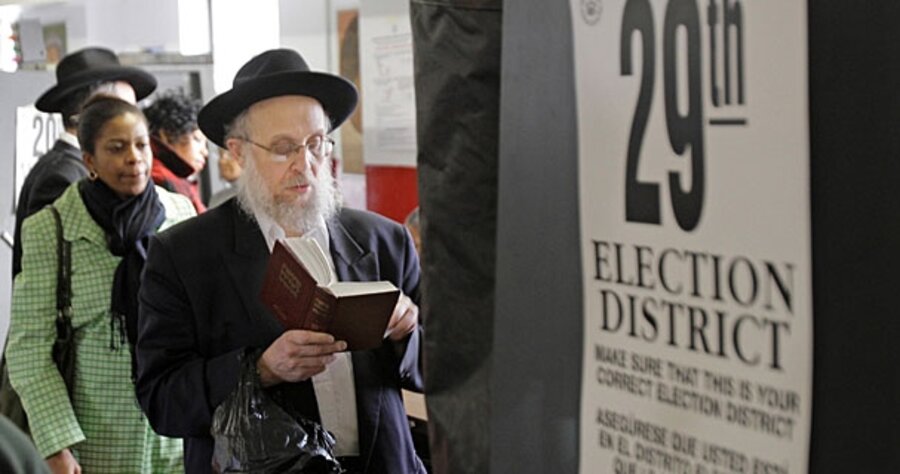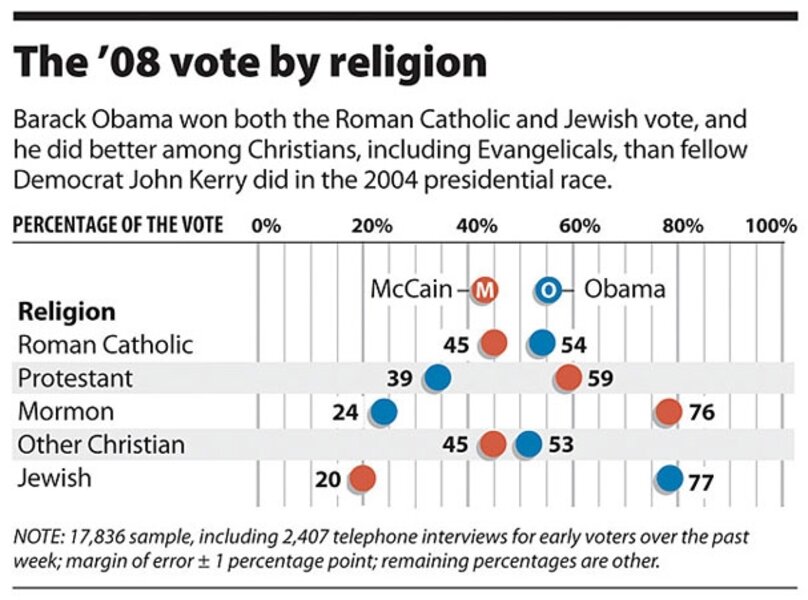Obama made inroads with religious vote
Loading...
| New York
This year it appears the Democrats got religion, at least in terms of the vote.
In becoming the president-elect, Barack Obama made gains among religious voters of almost every type compared with recent Democratic presidential candidates. He handily won the Catholic and Jewish votes, and even picked up support among Protestants and some Evangelicals, long a pillar of Republican ballot-box strength.
Republican John McCain did win more support than President-elect Obama among people who attend worship services at least once a week. He also won almost three-quarters of white Evangelicals – a margin smaller than President Bush’s in 2004. In the end, it wasn’t enough to overcome voters’ dissatisfaction with the past eight years of Republican rule.
Some theologians suggest that the religious shift signals the emergence of a faith-based coalition that will counterbalance or, perhaps, replace the religious right. It’s made up of mainline religious progressives, black and Hispanic Evangelicals, and a growing number of younger, white Evangelicals and Catholics.
A “whole new faith coalition is coming together and reaching out to allies in other faith traditions, both Jewish and Muslim,” says Jim Wallis, a theologian on religion and public life. “The generational shift [among Evangelicals and Catholics] is very significant. Many young Christians cast a post-religious-right ballot.”
During the campaign, both presidential camps made a point of reaching out to the opponent’s core religious constituencies. Obama’s campaign spearheaded a grass-roots drive to bring in young Evangelicals and Catholics. The McCain campaign relied more on surrogates like Sen. Joseph Lieberman (I) of Connecticut to try to bring Jewish voters into the GOP.
Their success varied. The McCain campaign had hoped to exploit Jewish voters’ initial unease with Obama, raising questions about the depth of his support for Israel and his willingness to negotiate with its enemies, such as Iran. It ran television ads in Florida and other places with large Jewish populations that quoted Iranian President Mahmoud Ahmadinejad: “Ahmadinejad says Israel won’t survive.... Obama says he would meet with him personally.”
Senator Lieberman, a leading political Jewish voice and a former Democratic vice presidential nominee, was frequently with Senator McCain on the stump. When he wasn’t, he was often in Florida working on behalf of his GOP Senate colleague.
Some Republicans also sought to exploit fears that Obama was secretly a Muslim or had close associations with anti-Semitic black leaders such as Louis Farrakhan.
That did not sit well with some Jews, who organized rabbis and others to counter such attacks on Obama.
Then there was Sarah Silverman to contend with. The young Jewish comedienne became the spokeswoman for the so-called Great Schlep. It signed up more than 25,000 young Jewish voters and urged them to go to Florida to get their grandparents to support Obama.
In a video that went viral on Youtube.com, she urged people to threaten not to visit their grandparents in Florida for a year if they vote for McCain.
“If they vote for Barack Obama, they’re going to get another visit this year,” she says. “If not, let’s just hope they stay healthy until next year.”
Obama managed to solidify Jewish support: 78 percent supported him over McCain, according to an analysis of election polls by the Pew Forum on Religion and Public Life. In 2004, 74 percent of Jewish voters backed Democrat John Kerry for president.
“Jewish voters finally trusted Barack Obama, but their support of him also showed they care about more than just Israel,” says Mr. Wallis.
The Obama campaign was more successful in making inroads with some of the GOP’s core constituencies. It reached out to Catholic voters who attend mass regularly – a group that went for Mr. Bush by 12 percentage points in 2004. This year, Obama and McCain split that vote. Among Catholics who attend mass less often, Obama won overwhelmingly.
“In 2004, Bush split with Kerry those Catholics who attended less often, but Obama won that group by 18 percentage points. That is a very significant shift,” says Luis Lugo, director of the Pew Forum on Religion and Public Life. “Part of the explanation is the significant shift to Obama among Hispanic Catholics.”
Obama also worked to reach out to the Republicans’ white evangelical base, but he had less success there. He did win more support among them than Senator Kerry did in 2004, but only by a few percentage points.
“When we’re looking at white Evangelicals, we’re looking at one of the strongest Republican constituencies in the country – a group that would be very hard to move into the Democratic column under any circumstances,” says John Green, senior fellow in religion and American politics at the Pew Forum. “From that perspective..., one could argue that this may be some evidence of success.”
Other analysts say Obama did make inroads with younger white evangelicals in key states like Colorado and Indiana, where he boosted his support among Evangelicals by 14 percentage points and 8 percentage points, respectively, over Kerry’s 2004 levels.






